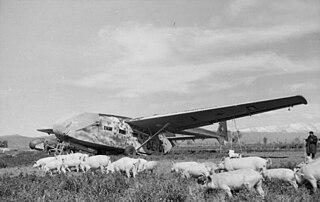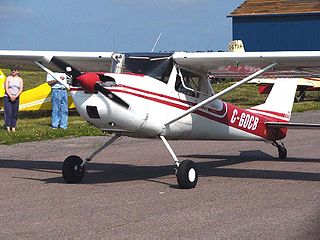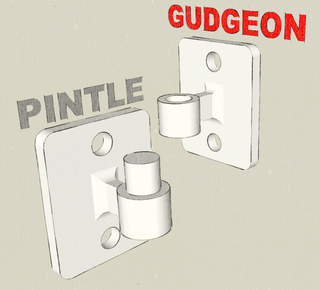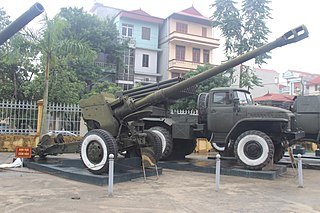
Landing gear is the undercarriage of an aircraft or spacecraft that is used for takeoff or landing. For aircraft it is generally needed for both. It was also formerly called alighting gear by some manufacturers, such as the Glenn L. Martin Company. For aircraft, Stinton makes the terminology distinction undercarriage (British) = landing gear (US).
A motor glider is a fixed-wing aircraft that can be flown with or without engine power. The FAI Gliding Commission Sporting Code definition is: a fixed-wing aerodyne equipped with a means of propulsion (MoP), capable of sustained soaring flight without thrust from the means of propulsion.

The Gotha Go 242 was a transport glider used by the Luftwaffe during World War II. It was an upgrade over the DFS 230 in both cargo/troop capacity and flight characteristics. It saw limited combat action. There were multiple glider variants, and it became the basis for a transport aircraft, the: Gotha Go 244.

The Junkers Ju 288, originally known within the Junkers firm as the EF 074, was a German bomber project designed during World War II, which only ever flew in prototype form. The first aircraft flew on 29 November 1940; 22 development aircraft were eventually produced.

Conventional landing gear, or tailwheel-type landing gear, is an aircraft undercarriage consisting of two main wheels forward of the center of gravity and a small wheel or skid to support the tail. The term taildragger is also used, although some argue it should apply only to those aircraft with a tailskid rather than a wheel.

A trunnion is a cylindrical protrusion used as a mounting or pivoting point. First associated with cannons, they are an important military development.
A limber is a two-wheeled cart designed to support the trail of an artillery piece, or the stock of a field carriage such as a caisson or traveling forge, allowing it to be towed. The trail is the hinder end of the stock of a gun-carriage, which rests or slides on the ground when the carriage is unlimbered.

A gudgeon is a socket-like, cylindrical fitting attached to one component to enable a pivoting or hinging connection to a second component. The second component carries a pintle fitting, the male counterpart to the gudgeon, enabling an interpivoting connection that can be easily separated. Designs that may use gudgeon and pintle connections include hinges, shutters and boat rudders.

A tow hitch is a device attached to the chassis of a vehicle for towing, or a towbar to an aircraft nose gear. It can take the form of a tow ball to allow swiveling and articulation of a trailer, or a tow pin, or a tow hook with a trailer loop, often used for large or agricultural vehicles where slack in the pivot pin allows similar movements. Another category is the towing pintle used on military vehicles worldwide.
In aviation, pushback is an airport procedure during which an aircraft is pushed backwards away from its parking position, usually at an airport gate by external power. Pushbacks are carried out by special, low-profile vehicles called pushback tractors or tugs.

The Bereznyak-Isayev BI-1 was a Soviet short-range rocket powered interceptor developed during the Second World War.

Towing is coupling two or more objects together so that they may be pulled by a designated power source or sources. The towing source may be a motorized land vehicle, vessel, animal, or human, and the load being anything that can be pulled. These may be joined by a chain, rope, bar, hitch, three-point, fifth wheel, coupling, drawbar, integrated platform, or other means of keeping the objects together while in motion.

The 152 mm gun-howitzer M1955, also known as the D-20, is a manually loaded, towed 152 mm gun-howitzer artillery piece, manufactured in the Soviet Union during the 1950s. It was first observed by the west in 1955, at which time it was designated the M1955. Its GRAU index is 52-P-546.

The 122mm D-74 towed gun is a Soviet-built gun. Developed in the late 1950s it provided direct and indirect fire for the Soviet Army. Today it is in reserve units with the Russian Army.
A weapon mount is an assembly or mechanism used to hold a weapon onto a platform in order for it to function at maximum capacity. Weapon mounts can be broken down into two categories: static mounts and non-static mounts.

The Allis-Chalmers M7 snow tractor was designed for use by the U.S. Army Air Corps as a rescue vehicle in remote northern bases.
The Greenwood Witch is an American ultralight aircraft that was designed and produced by Marvin Greenwood. The aircraft was supplied as a kit for amateur construction.
The Mikoyan-Gurevich I-7 was a development of the Mikoyan-Gurevich I-3 experimental fighter. Planned as a Mach 2-class aircraft, the I-7 was the second of a series of three experimental fighter aircraft from the Mikoyan-Gurevich design Bureau. Like the Mikoyan-Gurevich I-3, the I-7 was to be one of the components of the automated Uragan-1 then under development by protivovozdushnaya oborona strany, the Soviet defense system.
This aircraft, Messier's only aircraft and unnamed, was a one-off built to show the advantage of undercarriage retraction and the practicality of a bicycle wheel arrangement.





















